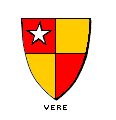
office (215)
233-4988
fax (000) 000-0000
Alt # (215) 000-0000
Brookfield Ancestor Project - Surety Barons
Magna Charta Baron Page
for
Robert De Vere
Earl of Oxford

Return to Barons at Runnymede Page
WURTS’ MAGNA CHARTA provided a brief accounting of the feudal headquarters of some of the Magna Charta Barons. Some of the castles have been badly damaged. Some have disappeared entirely. Often we can learn of them through Medieval and Renaissance accounts, and some of them require the discerning eye of the archeologist. Others await the evidence brought out with a shovel and pick, by the trained archeological historian.
A portion of the information concerning Surety Baron ROBERT de VERE is as follows:
The principal residence of the de VERES was Castle Headingham. The keep still stands sentry guard over the River Colne in the North of Essex, probably erected by Aubrey de Vere, who died in 1194. The Headingham keep ranks with that of Rochester as the finest of the square keeps in England.
Oxford Castle was the seat of the Earls de Vere. It now consists of little more than a Norman tower which stands inside the walls of a county jail. It was here that King Stephen laid siege to Matilda in 1141. She escaped by a rope ladder fashioned from bed sheets during the night and, fleeing, found refuge at Wallingford.
Oxford Castle is thought to be the oldest in all England. The Norman structure was built in 1071 by Robert d'Oilly. From what is left of it we can conclude that it was originally a pre-Norman motte and bailey fort. After the 1071 rebuilding, alterations were made by Henry II, between 1165 and 1173. He added the houses inside the shell keep, and also the well. He presumably built the diagonal keep on the motte, the foundations of which were discovered in the 18th Century.
ROBERT de VERE, the Surety, born after 1164, became heir to his brother, Aubrey de Vere, who died without issue before September of 1214, and who was reputed to be one of the "evil councillors" of King John. Although he was hereditary lord great Chamberlain of the kingdom, Robert pursued a different course in politics from that of his brother, and became one of the principal Barons in arms against King John, a party to that covenant which resigned the custody of the City and Tower of London to the Barons, and one of those excommunicated by the Pope. In the beginning of the reign of King Henry III, after he had made his peace with that young monarch following the Battle of Lincoln, Robert was received into his favor, and was appointed one of the judges in the Court of King's Bench, but he died only a few months afterward, 25~ October 1221, and was buried in the Priory of Hatfield, Broad Oak, in Essex. His wife was Isabel, who died 3 February 124S, daughter of Hugh, second Baron de Bolebec in Northumberland.
Appreciation is expressed to Reed M. W. Wurts, one of the Heralds of the Society for furnishing the Baron’s Shield on this page.
Return to Barons at Runnymede Page